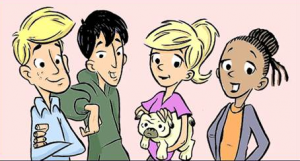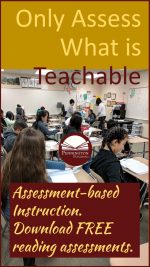Reading Intervention Programs
When teachers and administrators are looking for a reading intervention program, they will find no shortage of expensive, “research-based,” “evidence-based” high tech options. Countless districts and school sites have invested huge slices of their annual general funds to purchase big publisher programs that have produced minimal gains in reading achievement. Perhaps the “You get what you pay for” truism doesn’t always deliver with regards to effective reading intervention programs.
The Science of Reading Intervention Program includes comparable or superior resources to reading intervention programs costing thousands per student per year. What’s the difference, other than price?
This full-year 55 minutes-per-day program provides explicit and systematic whole-class instruction and assessment-based small group workshops to differentiate instruction. Both new and veteran reading teachers will appreciate the four training videos, minimal prep and correction, and user-friendly resources in this program, written by a teacher for teachers and their students.
The program provides 13 diagnostic reading and spelling assessments (many with audio files). Teachers use assessment-based instruction to target the discrete concepts and skills each student needs to master according to the assessment data. Whole class and small group instruction includes the following: phonemic awareness activities, synthetic phonics blending and syllabication practice, phonics workshops with formative assessments, expository comprehension worksheets, 102 spelling pattern assessments, reading strategies worksheets, 123 multi-level fluency passage videos recorded at three different reading speeds, writing skills worksheets, vocabulary worksheets, 644 reading, spelling, and vocabulary game cards (includes print-ready and digital display versions) to play entertaining learning games.
In addition to these resources, the program features the popular Sam and Friends Guided Reading Phonics Books. These 54 decodable books (includes print-ready and digital display versions) have been designed for older readers with teenage cartoon characters and plots. Each 8-page book introduces two sight words and reinforces the sound-spellings practiced in that day’s sound-by-sound spelling blending. Plus, each book has two great guided reading activities: a 30-second word fluency to review previously learned sight words and sound-spelling patterns and 5 higher-level comprehension questions. Additionally, each books includes an easy-to-use running record if you choose to assess. Your students will love these fun, heart-warming, and comical stories about the adventures of Sam and his friends: Tom, Kit, and Deb. Oh, and also that crazy dog, Pug. These take-home books are great for independent homework practice.
Detailed Teaching Reading Strategies Product Description
Simple Program Placement
The program includes four assessments to help teachers properly place students in the program: the *Vowel Sounds Phonics Assessment, the *Consonant Sounds Phonics Assessments, the *Diagnostic Spelling Assessment, and the Individual Fluency Assessment.
*Audio Files
Sound-by-Sound Spelling Blending
he scripted sound-spelling blending instructional sequence will help students learn to read all of the common sound-spellings in just 18 weeks of synthetic phonics instruction.
Reading Fluency Practice
Students practice reading fluency (modeled readings, repeated practice, cold and hot timings recorded on timing charts) with 43 expository articles, each written about a common or uncommon animal.
Each of the engaging articles is composed in a leveled format—the first two paragraphs are at third grade reading level, the next two are at the fifth grade reading level, and the last two are at the seventh grade reading level. Slower readers get practice on controlled vocabulary and are pushed to read at the higher reading levels, once the contextual content has been established. Faster readers are challenged by the increasingly difficult multi-syllabic vocabulary.
The program provides two options for fluency practice: 1. Small group choral readings (no technology required) and 2. YouTube videos with modeled readings at three different speeds for each of the 43 articles.
Comprehension Worksheets
The SCRIP Comprehension Worksheets help students learn and practice comprehension cues (summarize, connect, re-think, interpret, and predict) to independently access the meaning of texts. The 43 expository articles are the same as those used in the reading fluency practice. Each worksheet includes five text-dependent comprehension questions and three context clues vocabulary words.
Reading Comprehension Strategies
Teacher lessons, guided reading practice, and Reading Strategy Worksheets will help your students learn to self-monitor their reading and improve comprehension.
Diagnostic Assessments
With canned reading intervention programs, teachers wind up spending too much time teaching what many of their remedial readers already know and too little time helping students practice what they do not know.
The 13 whole-class diagnostic reading assessments pinpoint the specific reading deficits for each of your students. Everything you need to teach (or not teach) is assessed and instructional resources match every assessment item.
The 13 program assessments include…
Syllable Awareness, Syllable Rhyming, Phonemic Isolation, Phonemic Blending, Phonemic Segmenting, Alphabetic Upper and Lower Case Letter Match and Alphabetic Sequencing, Vowel Sounds Phonics Assessment, Consonant Sounds Phonics Assessment, Heart Words Assessment, Diagnostic Spelling Assessment, and an Individual Fluency Assessment
All assessment data is recorded on two comprehensive reading recording matrices for simple progress monitoring and placement in flexible small group workshops. Each workshop activity has a brief formative assessment to determine whether students have mastered the skill or need more practice.
Phonemic Awareness Lessons
The program includes extensive phonemic awareness activities which perfectly correspond with the phonemic awareness assessments. Students fill in the gaps to ensure a solid foundation for learning the phonetic code by learning to hear, identify, and manipulate the phonemes.
Workshops include alphabetic awareness, rhyming, syllable awareness and manipulation, phonemic isolation, blending, and segmentation.
Phonics Lessons
the program includes 35 phonics small group lessons, targeted to the vowel and consonant sounds phonics assessments.
Spelling Pattern Workshops
The 102 Spelling Pattern Worksheets correspond to each test item on the Diagnostic Spelling Assessment. Students complete spelling sorts, rhymes, word jumbles, and brief book searches.
Decodables: The Sam and Friends Guided Reading Phonics Books
The Sam and Friends Guided Reading Phonics Books features 54 eight-page decodable stories with teenage characters, high-interest plots, and non-juvenile cartoons. Each book has embedded reading comprehension questions, word fluency timings, and accompanying running records. The books are formatted as booklets for printing and digital display on phones, tablets, and Chromebooks.
Each book has focus sound-spellings (the same ones as in the Sound-Spelling Blending activity) and sight words. Students learn the blends and practice them in the decodable Sam and Friends books. The 5 comprehension questions per story are ideal for guided reading instruction and parent-supervised homework.
Additionally, all 54 books provide a 30-second word fluency practice on the focus sound-spellings and sight words with a systematic review of previously introduced sound-spellings and sight words. Your students will improve reading fluency as they develop automaticity with the common sound-spellings and high utility sight words.
Each story has a custom-designed running record assessment with 200 words. Teachers may choose to complete running records on unpracticed or practiced books and may decide to assess with every book, once a week, or at the end of the phonics collection.
Syntax in Reading Lessons
Grammar and usage taught through its function. Students analyze challenging syntactic sentences and are given the tools (both reading and writing) to analyze and build comprehension.
Executive Function Lessons
Get 53 solid lessons to built students’ capacity to learn.
Vocabulary Worksheets
The Vocabulary Worksheets used in this workshop focus on the CCSS Vocabulary Standards:
- Multiple Meaning Words and Context Clues (L.4.a.)
- Greek and Latin Word Parts (L.4.a.)
- Language Resources (L.4.c.d.)
- Figures of Speech (L.5.a.)
- Word Relationships (L.5.b.)
- Connotations (L.5.c.)
- Academic Language Words (L.6.0)
The Science of Reading Intervention Program
The Science of Reading Intervention Program: Word Recognition includes explicit, scripted instruction and practice with the 5 Daily Google Slide Activities every reading intervention student needs: 1. Phonemic Awareness and Morphology 2. Blending, Segmenting, and Spelling 3. Sounds and Spellings (including handwriting) 4. Heart Words Practice 5. Sam and Friends Phonics Books (decodables). Plus, digital and printable sound wall cards and speech articulation songs. Print versions are available for all activities. First Half of the Year Program (55 minutes-per-day, 18 weeks)
The Science of Reading Intervention Program: Language Comprehension resources are designed for students who have completed the word recognition program or have demonstrated basic mastery of the alphabetic code and can read with some degree of fluency. The program features the 5 Weekly Language Comprehension Activities: 1. Background Knowledge Mentor Texts 2. Academic Language, Greek and Latin Morphology, Figures of Speech, Connotations, Multiple Meaning Words 3. Syntax in Reading 4. Reading Comprehension Strategies 5. Literacy Knowledge (Narrative and Expository). Second Half of the Year Program (30 minutes-per-day, 18 weeks)
The Science of Reading Intervention Program: Assessment-based Instruction provides diagnostically-based “second chance” instructional resources. The program includes 13 comprehensive assessments and matching instructional resources to fill in the yet-to-be-mastered gaps in phonemic awareness, alphabetic awareness, phonics, fluency (with YouTube modeled readings), Heart Words and Phonics Games, spelling patterns, grammar, usage, and mechanics, syllabication and morphology, executive function shills. Second Half of the Year Program (25 minutes-per-day, 18 weeks)
The Science of Reading Intervention Program BUNDLE includes all 3 program components for the comprehensive, state-of-the-art (and science) grades 4-adult full-year program. Scripted, easy-to-teach, no prep, no need for time-consuming (albeit valuable) LETRS training or O-G certification… Learn as you teach and get results NOW for your students. Print to speech with plenty of speech to print instructional components.
Get the SCRIP Comprehension Strategies FREE Resource:
Get the Diagnostic ELA and Reading Assessments FREE Resource:








